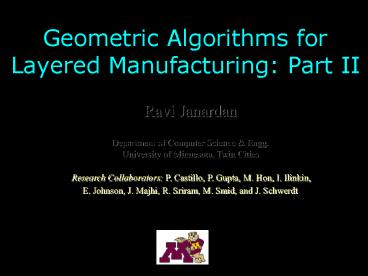Geometric Algorithms for Layered Manufacturing: Part II - PowerPoint PPT Presentation
Title:
Geometric Algorithms for Layered Manufacturing: Part II
Description:
Geometric Algorithms for Layered Manufacturing: Part II Ravi Janardan Department of Computer Science & Engg. University of Minnesota, Twin Cities – PowerPoint PPT presentation
Number of Views:88
Avg rating:3.0/5.0
Title: Geometric Algorithms for Layered Manufacturing: Part II
1
Geometric Algorithms for Layered Manufacturing
Part II
Ravi Janardan Department of Computer Science
Engg. University of Minnesota, Twin Cities
Research Collaborators P. Castillo, P. Gupta, M.
Hon, I. Ilinkin, E. Johnson, J. Majhi, R.
Sriram, M. Smid, and J. Schwerdt
2
Rapid Physical Prototyping
- 3D printing technology that creates physical
prototypes of 3D solids from their digital models - Used in the automotive, aerospace, medical
industries, etc., to speed up the design cycle
3
Layered Manufacturing
- Builds 3D models as a stack of 2D layers
Stereolithography
4
Geometric Considerations
- The choice of build direction affects quality and
performance measures
5
Overview of Recent LM Research(http//www.cs.umn.
edu/janardan/layered)
- Geometric algorithms for
- minimizing surface roughness
- minimizing of layers
- protecting critical facets
- minimizing support requirements
- and trapped area in 2D
- Exact/approx. geometric algorithms for tool path
planning (polygon hatching) - Decomposition-based approach to LM
- Algorithms to approximate the optimal support
requirements
6
Problem 1Decomposition-Based Approach
- Decompose the model with a plane into a small
number of pieces - Build the pieces separately
- Glue the pieces back together
7
Polyhedral Decomposition
- Decompose a polyhedron P into K pieces with a
plane H normal to a given direction d
- Goal Minimize volume of supports or contact area
when the pieces are built in directions d and -d
8
Minimizing Contact-Area (CA) for Convex Polyhedra
- CA depends on height of H and orientation of
facets - e.g. back facet f (nf d lt 0)
9
Overall Algorithm
- sweep-based algorithm
- initialize (sort vertices, set CA term)
- general step at vertex v (update CA term)
- minimize new CA term
10
Overall Algorithm (contd)
- General step details update CA term
11
Experimental Results
- random points on a rotated ice-cream
cone
12
Non-convex Polyhedra
- the structure of supports is more complex
convex
non-convex
13
Black/Gray Triangles
- partition each front and each back facet into two
classes of triangles
black tri. always in contact with
supports gray tri. contact with supports
depends on the position of H
14
Computing Black/Gray Triangles
- Compute supports for undecomposed polyhedron
using cylindrical decomposition
15
Overall Algorithm
- compute cylindrical decomposition
- apply convex algorithm on gray triangles
- Run-time O(n2 log n), space O(n2)
16
(No Transcript)
17
Problem 2 Approximating the Optimal Support
Requirements
- Given a polyhedral model, compute a build
direction for which the support contact-area is
close to the minimum - (there is no model decomposition here).
- Identify heuristics for choosing candidate
directions - Design efficient algorithms to compute
contact-area for chosen directions - Develop a criterion to evaluate the quality of
each heuristic, via easy-to-compute quantities
18
Preliminaries
- CA(d) contact area for build direction d
- CA(d) BFA(d) FFA(d) PFA(d)
- BFA(d) back facet area for d
- FFA(d) front facet area for d
- PFA(d) parallel facet area for d
d
d
d
19
Evaluation Criterion
d build direction computed by heuristic d
optimal build direction d direction which
minimizes BFA
20
Compute CA
- compute BFA, FFA and PFA for direction d
- compute FFA
21
22
(No Transcript)
23
Heuristics
- Min BFA direction that minimizes the area of
back facets
- Max PFA direction that maximizes the area of
parallel facets
- Max PFC direction that maximizes the number of
parallel facets
- PC direction that corresponds to the principal
components of the object
- Flat direction that corresponds to a facet of
the convex hull of the object
24
prism
triad1
ecc4
pyramid
3857438
f0m27
mj
tod21
bot_case
oldbasex
carcasse
top_case
25
- Columns shows upper bound on
26
Conclusions
- Efficient algorithms for decomposing polyhedral
models - Heuristics and evaluation criterion for
approximating optimal build direction so as to
minimize contact-area - Applications to Layered Manufacturing
27
Acknowledgements
- STL models courtesy Stratasys, Inc.
- Research supported in part by NSF, NIST, Army HPC
Center (U of Minn.), and DAAD (Germany) - Papers at http//www.cs.umn.edu/janardan/layered
28
Controlling Decomp. Size (K )
- Partition the d-direction into intervals Ij s.t.
any plane in Ij splits P into same number of
pieces kj - Optimize only within intervals where kj lt K
- Two-sweep algorithm
- up-sweep pieces for P-
- dn-sweep pieces for P
- Combine results of sweeps
- Use Union-Find data str.































